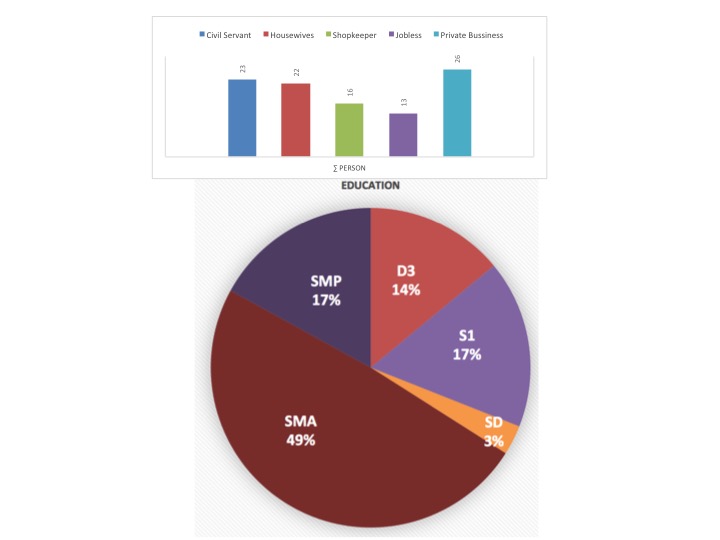A Millennial Generation Perception of Waisai District about Water Conservation Area the Raja Ampat Region
Millennial Generation Perception Of Waisai District About Water Conservation Area The Raja Ampat Region
DOI:
https://doi.org/10.46252/jsai-fpik-unipa.2023.Vol.7.No.4.378Keywords:
Perception, millenial generation, the water conservation area, Raja AmpatAbstract
The Raja Ampat Water Conservation Area aims to protect and preserve biodiversity in the region, which is part of the Sea of the Head of the Birds of Papua. The Waisai District, the capital of Raja Ampat Regency, has the highest population of all the districts in Raja Ampat, with a population of 23,36 thousand people in 2023. The millennial generation has the highest percentage of 46% in the demographics of Raja Ampat District, making them an active audience segment in the country. The research method used in this study involved disseminating questionnaires using simple random sampling (SRS) to collect data from the millennial generation in Waisai City, India. The sample size was 10,057 people aged 20–44 in 2021. The study used the Slovin formula with a 90% confidence level. The total sample was 100 responden. The data was analyzed using Likert scale measurements, with each answer given a score. The assessment of respondents' interpretation of the conservation area perception was assessed using the index percentage formula. The conclusion of the discussion is that the Millennial Generation's perception of Raja Ampat Water Conservation Area is 58.47%, which falls within the criteria of “fair” or not fully understood. The results of the study showed that respondents' knowledge of conservation areas, both legislative, regulatory, territorial administrative boundaries, and zooning programs, was at a score below 60. Information on social media had a real impact on knowledge related to the status of the conservation area of Papua. The greatest perception score was about the four zonings on King Ampat's conservation status because many respondents were aware of it from various campaigns and socialization from various viewpoints.
Downloads
References
Adu, S. J., Salampessy, M. L., & Iskandar, S. (2019). Persepsi masyarakat terhadap konservasi Harimau Sumatera (Panthera tigris sumatrae) di Taman Nasional Kerinci Seblat (Studi kasus Desa Pungut Mudik dan Desa Pungut Hilir). Jurnal Nusa Sylva, 19(1), 22–29.
Aragão, D. L., Paulus, I. G. N., Nuraini, K. V. C., White, A., & Gunawan, T. (2020). Pariwisata Berkelanjutan di Kawasan Konservasi Perairan. Buku Pedoman Praktis untuk Implementasi di Indonesia (Melva Aritonang & Deborah Lilienfeld Aragão, Eds.). Marine Change untuk Proyek USAID SEA.
Firdiansyah, A., Johan, Y., & Ta’alidin, Z. (2020). Persepsi dan partisipasi masyarakat dalam pengelolaan kawasan konservasi perairan Pulau Enggano Provinsi Bengkulu. Naturalis: Jurnal Penelitian Pengelolaan Sumber Daya Alam Dan Lingkungan, 9(1).
Herawati, N., & Sudagung, A. D. (2020). Persepsi Masyarakat dan Potensi Public Acceptance Terkait Wacana Pembangunan PLTN di Kabupaten Bengkayang. Jurnal Pengembangan Energi Nuklir, 22(2), 111. https://doi.org/10.17146/jpen.2020.22.2.6125
Hukom, F. D., Yulianda, F. D. G., & Kamal, B. M. M. (2019). Efektivitas zonasi dalam pengelolaan perikanan karang di kawasan konservasi perairan Selat Dampier, Raja Ampat. Jurnal Kebijakan Sosial Ekonomi Kelautan Dan Perikanan, 9(2), 93–103.
Nugraheni, A. I. P., Nugraha, B. S., Yuda, N. P., & Pancawati, N. (2019). Persepsi Generasi Milenial Indonesia Terhadap Pariwisata Yang Berkelanjutan. Kepariwisataan: Jurnal Ilmiah, 13(1).
Paisal, Y., Mahsyar, A., & Wardah, W. (2019). Pembimbingan Kader Pemuda Motivator Pelestari Lingkungan Hidup. JCES (Journal of Character Education Society), 2(1), 19–23.
Parhusip, N. E., & Arida, I. S. (2018). Wisatawan Milenial di Bali (Karakteristik, Motivasi, dan Makna Berwisata). Jurnal Destinasi Pariwisata, 6(2), 299–303.
Pemprov Papua Barat. (2018). RENCANA PENGELOLAAN DAN ZONASI KAWASAN KONSERVASI PERAIRAN KEPULAUAN RAJA AMPAT TAHUN 2019 - 2038.
Pratama, A. M., Sudana, I. P., & Wijaya, N. M. S. (2020). Analisis Pola Perjalanan Dan Aktivitas Wisatawan Milenial Mancanegara Ke Desa Pecatu, Badung. Jurnal IPTA P-ISSN, 8(1), 2020.
Purwanto, D. M. I. R. H. F. Y. M. A. A. W. H. N. M. A. R. M. A. B. E. M. I. M. M. L. H. D. O. B. D. dan E. D. L. R. (2021). Laporan Status Ekologi Kawasan Konservasi Perairan Selat Dampier, Raja Ampat Tahun 2021. Universitas Papua, Unit Pelaksana Teknis KKP Raja Ampat, Balai Besar Taman Nasional Teluk Cenderawasih, Conservation International, Yayasan Konservasi Alam Nusantara, RARE Indonesia. Manokwari, Sorong, Raja Ampat, Bogor Indonesia.
Qodir, F., Mauludiyah, Maisaroh, D. S., Violando, W. A., Johan, O., Idris, Nurliah, & Waspodo, S. (2023). Zoning Effectiveness of Marine Nature Reserve Conservation Areas (SAP) Raja Ampat Islands Against Coral Reef Protection. Jurnal Biologi Tropis, 23(1), 420–431. https://doi.org/10.29303/jbt.v23i1.4623
Rachim, S., & Gunawan, H. (2022). Persepsi Pengunjung Pameran HCPSN terhadap Konservasi Alam dan Strategi Promosi Konservasi di Masa Pandemi. Jurnal Pariwisata Terapan, 6(1), 1–14.
Sopyan, A., & Wibowo, S. W. A. (2006). Potret pembelajaran sains di SMP dan SMA. Jurnal Pendidikan Fisika Indonesia, 4(2).
Tebay, S., Kaber, Y., Angin, E. P., Manangkalangi, E., Manuputty, A., & Rumayomi, M. R. (2021). Relationship between Perception and Socio-Economic Characteristics of Culture Community in the Development of Marine Ecotourism in Nusmapi Island. Jurnal Sumberdaya Akuatik Indopasifik, 5(4), 373–386.
Widayatun, N. F. N. (2016). Peran masyarakat dalam pelestarian terumbu karang dan dampaknya terhadap peningkatan kesejahteraan. Jurnal Kependudukan Indonesia, 6(2), 1–19.

Downloads
Published
How to Cite
Issue
Section
License
Copyright (c) 2023 Anastasia Gustiarini

This work is licensed under a Creative Commons Attribution-ShareAlike 4.0 International License.


















